Understanding Intel's Dynamic Power and Thermal Framework 8.1: Smarter Throttling
by Joshua Ho on August 21, 2015 8:00 AM EST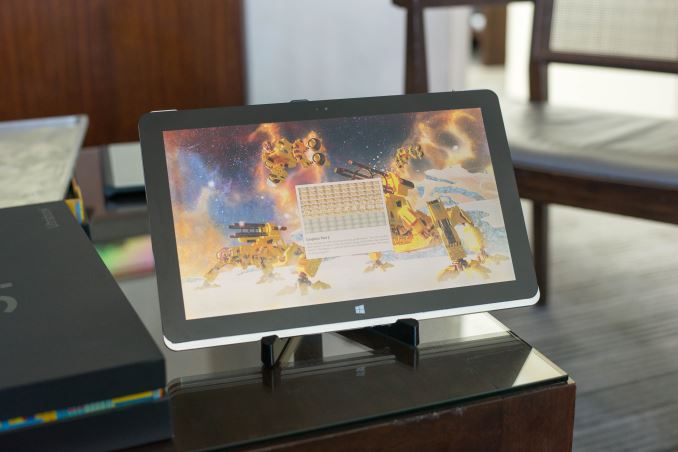
In mobile, thermal throttling is effectively a fact of life as modern, thin tablets and smartphones leave little room for implementing high-performance fans. We can use CMOS scaling to try and reduce the amount of power consumption, but in order to keep up with increasing performance demands it’s important to also scale performance as well.
This means that while performance per watt will increase from generation to generation thanks to manufacturing and architectural improvements, finding ways to allow CPUs to use more power is also part of the equation in order to get the best possible performance out of a passively cooled device. This has been evidenced in recent years by the ever-increasing dynamic power ranges for mobile CPUs, which has seen idle power consumption drop while maximum load power consumption has risen.
By increasing the dynamic range of these CPUs, it has allowed manufacturers to further optimize their devices for workloads that require high CPU performance for only short periods of time, a surprisingly common workload. For the end user then, there’s a clear benefit to both effective turbo and thermal management, as any kind of race to sleep workload sees benefit from turbo clocks, while long-running high-load workloads benefit significantly from smart thermal management.
Although Intel’s Dynamic Platform and Thermal Framework (DPTF) 8.1.x has been out for months now, these features haven’t really received much attention so far. For those that are probably unaware of what Intel’s DPTF is, it’s effectively Intel’s solution to managing throttling in a smart manner according to the TDP limits of the device based upon thermal sensors and power monitoring for x86 tablets, 2-in-1s, and PCs in general. If you think this sounds a lot like ARM’s Intelligent Power Allocation in some ways, you’d be right.
For the most part, previous iterations of DPTF have been pretty standard in the sense that they rely on a fixed correlation between temperature sensors and critical values like Tskin max and Tjunction max of all chips on the board. As these devices are unable to directly read skin temperatures, the system must instead infer what Tskin should be. And once certain temperature sensors read out certain values, the system assumes that the skin temperature has reached a maximum value, which means it’s necessary to begin throttling the system. Similarly, if an on-die chip sensor reads a specific value that is close to the maximum junction temperature, the system will react by throttling appropriately.
However in the case of DPTF 8.1, this system has changed. Instead of a fixed correlation, the system is now adaptive depending upon a number of factors. One of the key examples cited is device orientation, as how a device is placed has a significant impact on its ability to cool itself. For example, when a tablet is placed flat on a table with the display up, the back of the tablet is unable to rely on convection and ambient air flow to cool the back cover. With previous iterations of DPTF, this worst-case style setup was what was used to determine how to correlate temperature sensors with skin temperatures.
The problem with that approach was that when the device was placed in a situation where cooling was better, such as held vertically in the air or held in a dock with a circulation fan, DPTF wouldn’t change the temperature sensor correlations to skin temperature. This meant that in long run TDP-gated situations that the device was throttled to a greater extent than truly necessary.
It turns out this one change has enormous effects on performance in these thermally limited situations. With a vertical orientation, heat dissipation and thereby power headroom increases by 66%. With an active cooling dock, power headroom increases by 97%. As Intel reasons and as their data backs up, there are clear benefits in not being conservative with throttling in situations where physics says cooling performance is better than the worst case scenario.
Of course, system performance won’t increase by quite those levels due to the fact that CPU power draw increases quadratically with clock speed. According to Intel, in benchmarks this leads to an average performance increase of about 35%, with some use cases showing as much as double the performance in this mode.
Ultimately, coming from IDF 2015 it isn’t clear at this time when we can expect this to show up in 2-in-1s, tablets, and other devices. But given that DPTF is a software suite it’s well within possibility that devices already out there with DPTF could receive an update that implements these improved throttling mechanisms.


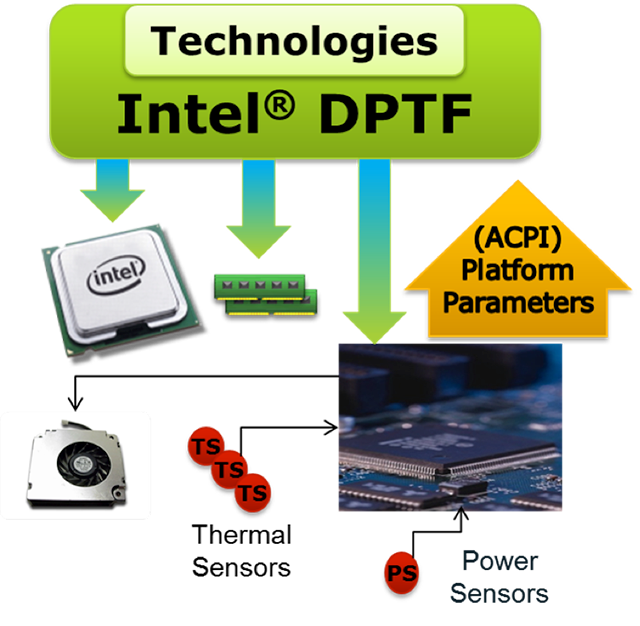

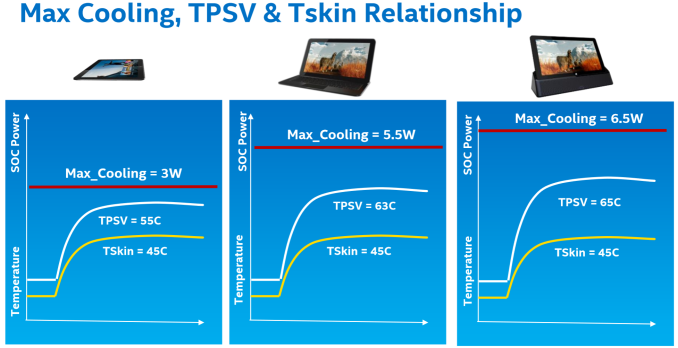
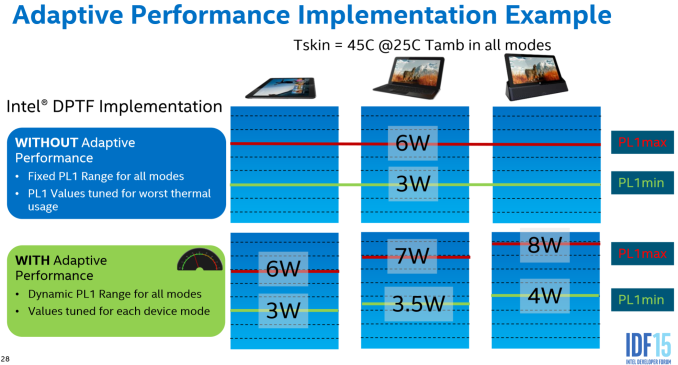
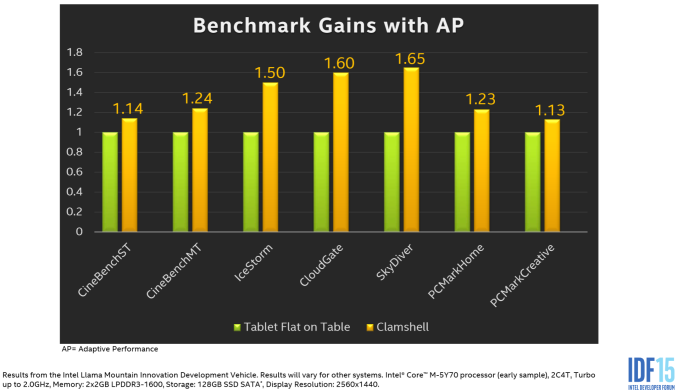









32 Comments
View All Comments
Drumsticks - Friday, August 21, 2015 - link
I really hope that Microsoft and Intel are working closely together on the SP4. It could be the perfect device with just the right amount of reputation to showcase everything both companies have been building to in the last year.V900 - Friday, August 21, 2015 - link
I hope for their own sake, that they're not that dumb. I cant imagine anything, that would cause OEMs to run even faster towards ARM based Chromebooks, than Microsoft and Intel working closely together on a Surface device.Spunjji - Friday, August 21, 2015 - link
You're a bit late on that prediction given that they already had a close partnership on the SP3 at the very least.Stahn Aileron - Friday, August 21, 2015 - link
Honestly, the professional mobile device market needs that type of kick in the pants. Microsoft needs something to showcase what their software development can accomplish. It's the same for Intel on the hardware side. The OEMs for the longest time couldn't produce a product in that market with the traditional business methods (i.e. the OEMs build a finalized, integrated product based on Wintel tech) that wasn't half-assed. The first Surface showcased what Windows 8 on a properly designed tablet could do. The market has gotten slightly better for it since MS was willing to pave the way (read: take the risk) and show the OEMs (read: its partners) how to do it.Besides, MS knows not to completely walk all over its partners. There's a reason why the Surface models are placed where they are. There are plenty of market gaps for the OEMs to fill in if they want. MS needed a flagship device to showcase its software. "If you want something done right, do it yourself." (And by "right", I mean to your own expectations.)
Disclosure: I'm an owner of a Surface Pro 2. It's currently the ONLY way I can stand (and actually like) Windows 8.1. I am eagerly awaiting news of the SurPro4. (Too bad Courier never made it as a finalized product. I sometimes wonder if MS is keeping that experiment in mind.)
Visual - Friday, August 21, 2015 - link
To say that Surface paved the way to anything seems funny to me.There were promising earlier contenders like Asus EP121 or Samsung Ativ Pro and others. While they had their drawbacks, so too did Surface.
I have a Pro 2 like you, and know first-hand of how well it "showcased MS software" - the appalling situation with its type-cover touchpad drivers, for example. Or how "properly designed" its cooling system or even the power-port really was...
Don't get me wrong. I don't hate my Surface. It's still the best in its category when it launched. But it has room for improvement, in certain aspects in very obvious ways, and I'm a bit disappointed MS did not get it to its full potential.
basroil - Friday, August 21, 2015 - link
"Don't get me wrong. I don't hate my Surface. It's still the best in its category when it launched. But it has room for improvement, in certain aspects in very obvious ways, and I'm a bit disappointed MS did not get it to its full potential."They did just a few months later when they released the Surface Pro 3. It solved just about every gripe you and others had.
Lonyo - Friday, August 21, 2015 - link
I have an Ativ Pro, and the fact that after 3 years Samsung haven't released a new one says a lot when Microsoft are closing on v.4 product.Samsung have shown they don't give a shit about this type of product so they didn't pave the way for much. Surface Pro was announced before the Ativ was anyway.
Stahn Aileron - Saturday, August 22, 2015 - link
I see what you mean. I guess I didn't quite state my argument the way I meant.By "paving the way," I meant the Surface gave the other OEMs a clear(er) direction to aim at for device design. There were promising designs as you stated, but the drawback they had tended to be more concentrated in one area than the Surface (if I recall the reviews from then correctly. Do correct me if I'm wrong.) The Surface was one of, if not the first, to attempt to address those shortcomings in OEM designs. The Surface line had some shortcomings, yes, but IMHO, they were more balanced all around than prior designs.
Lastly, don't forget you're looking at the Surface line through the lens of hindsight. It will color opinion (much like any else can.)
melgross - Sunday, August 23, 2015 - link
I think you guys are assuming too much. It's very clear that me was going for large hardware sales. When Ballmer said "Devices" as part of Microsoft's new mission, he wasn't talking about low sales to lead the OEMs forward. He meant selling tens of millions a year. That vision failed, and instead, if they sell 4 million Surface Pro 3 devices this year, it will be an accomplishment.At this point, it's become clear to Microsoft that device sales aren't going to be their future, so they reluctantly changed direction.
This is true when major companies have sales that disappoint. The can talking about "leading the industry" and all that, but that's just face saving. So while it's true that Surface sales have been increasing, they are at such a low level that just a few hundred thousand a year in an increase looks large.
BrokenCrayons - Friday, August 21, 2015 - link
OEMs will produce systems that generate sales and offer lucrative profit margins. I don't think any relationship between Microsoft and Intel will ultimately have a large impact that dictates the decisions other companies make in selecting a product lineup. There are numerous OEMs that currently produce Chromebooks and if that market becomes larger through their success, it's likely other companies will join in the fray, but I think that the driver for their entry isn't going to be due to halo products like the Surface Pro that simply don't compete directly with the market segment to which Chromebooks appeal.